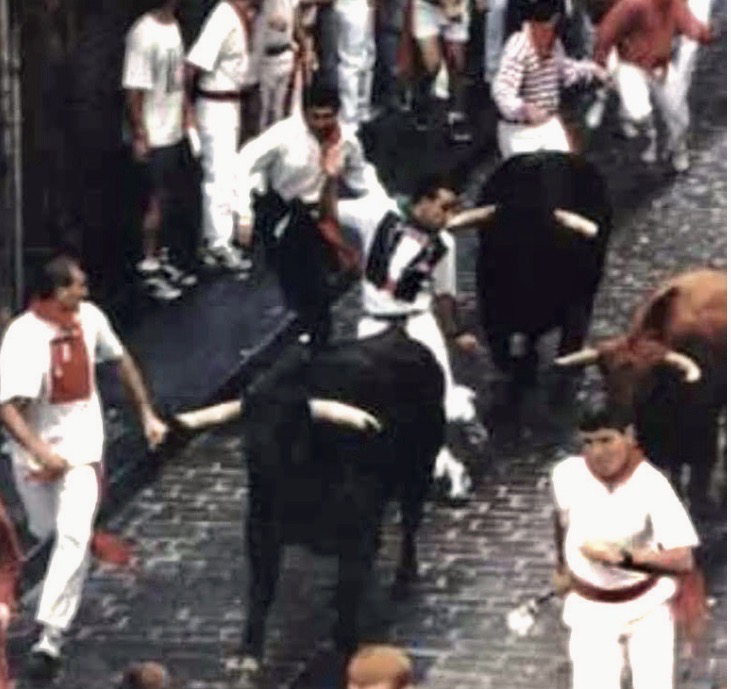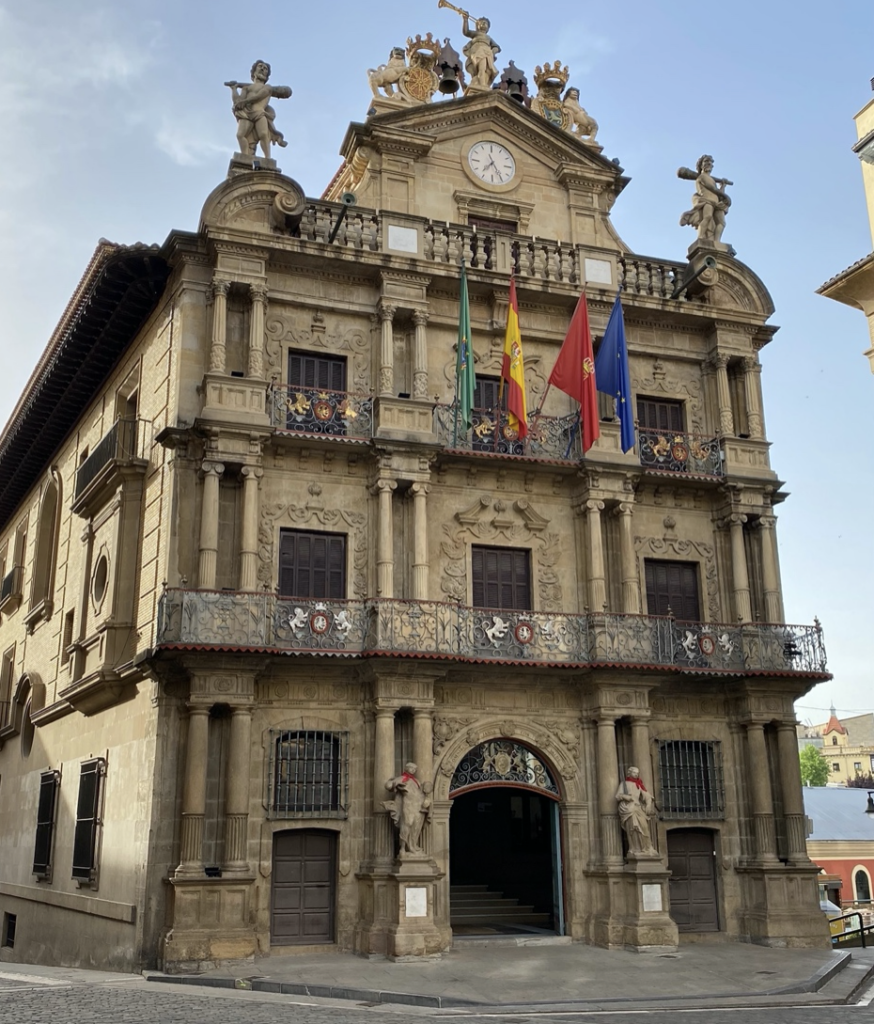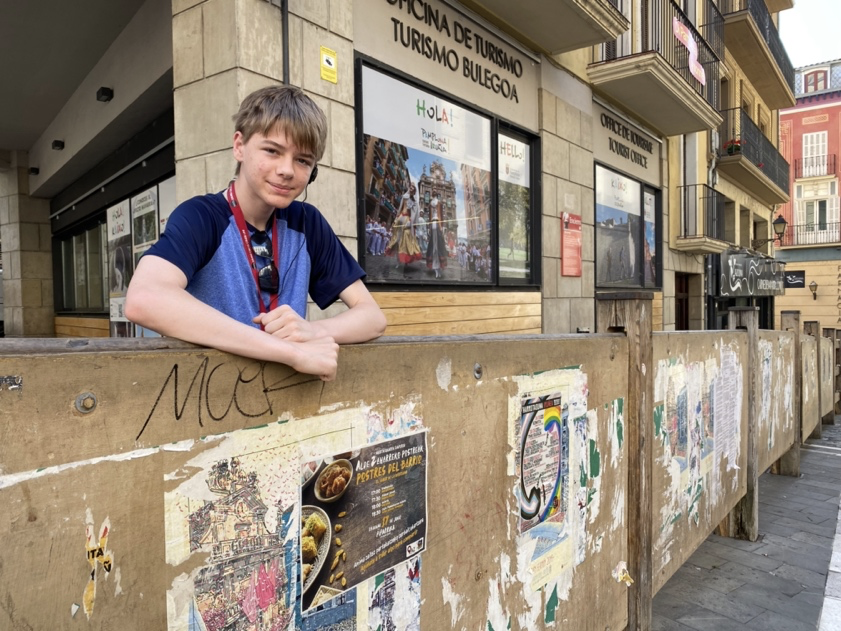Want to truly face danger? Consider running with the bulls in Pamplona

PAMPLONA, Spain — Nothing says July in America more than the Fourth.
In Spain, it’s the running of the bulls.
Bull runs, or encierros, are held all over Spain. The most famous is in Pamplona.
Grandson Benjamin St. John and I were in Pamplona considering whether we might give the sport a try. (Yes, they call it a sport.)
This year provided the opportunity to run with the bulls after a two-year pandemic hiatus. The two of us, along with my wife, Martha, practiced our running and defensive techniques with safe, stuffed but full-size bulls.
Pamplona was eager to return to the tradition with runs scheduled for July 7-14. America media usually reports only the first run unless there is a death or runners gored. The opportunity to run with the bulls, though, continues for an entire week during the festival of San Fermin. A fresh group of bulls heads for the bullring each day.
Gorka Cia, a veteran bull runner, provided us with a first-hand account of the roughly 1,000-yard bull run lasting no more than five minutes. Each runner joins in for a small (but potentially deadly) portion of the run. (Gorka’s Facebook page is GorkaCia in case you’d like the tour.)

Run honors Saint Fermin
The running of the bulls honors Saint Fermin. He isn’t a saint I’d ever heard of, but Ben and I learned every town in Spain had a patron saint or two. (Might be a healthy idea to consider for our communities!)
Legend has it that Saint Fermin, a bishop, was martyred in the third century by being dragged by a bull with others running after him — and so, the tradition of the bull run. (Other accounts report that he had been imprisoned and later beheaded, but we can ignore such details when establishing a tradition.) The festival honoring Saint Fermin dates from at least the 13th century.
Runners gather at a single entrance. They are mostly dressed in white with a red waistband and kerchief. The white outfits are said to represent the purity and holiness of the saint, and the red represents his death. A rolled-up newspaper is carried to distract the bulls if the need should arise. Participants must be at least 18 years old, do nothing to incite the bulls and be sober.
Interest in the encierro was boosted by Ernest Hemingway’s description of Pamplona’s “fiesta” in his 1926 novel “The Sun Also Rises.” His characters, though, drank so heavily during the fiesta that none would be eligible for the run. Perhaps this, too, explains why Hemingway never ran with the bulls in Pamplona.

Runners begin with benediction
The runner gate is opened. The runners rush in. For a bit of saintly protection, runners gather for a soulful benediction before a walled image of Saint Fermin. Gorka sang it for us: “We ask Saint Fermin, as our patron, to guide us through the encierro and give us his blessing.” The runners then repeatedly shout “Viva San Fermin!”
A rocket is set off to alert runners that that six bulls are released. They are accompanied by six oxen that guide the bulls along the route to the bullring. The oxen do not go to their fate in the bullring as will the bulls. They run with bulls each day during the festival.
Gorka guides us to his favorite spot along the run. Some runners cower to sidelines where the bulls are unlikely to charge and safely pass by. Not Gorka. He shares daring photos of himself, at times inches from the bulls.

Gorka’s favored spot was about halfway through the run when the bulls have tired a bit and make a critical turn after the City Council of Pamplona building. There, a runner can get close to the bulls and truly run with them.
He shows us several scars from gores. He gave up the runs after suffering a head injury. His son, not yet 18, is undecided whether to take up the sport.
Why run with the bulls?
Why do it?
Gorka didn’t respond in words. He extends his arms in an “The Incredible Hulk” fashion, tightens his fists, shows his muscled strength with a shake and lets out a big smile. It’s the thrill of being brave, strong and having the manly courage to face danger.
Leave no doubt. The run isn’t just for men. Starting in 1974, women could join the previously male-only event.

The community impact of the running of the bulls is significant. Pamplona balloons from a population of around 200,000 to more than one million. Estimates are that the partygoers add roughly $150 million to the economy during the nine days.
(Perhaps something our communities might consider? I doubt, though, a bull run down our streets would be a welcomed event.)
Injuries and deaths are not uncommon. Gorka said if you fall during the run, stay down until someone taps you to get up. The bulls are raised to be aggressive, but the oxen are not and usually step over or around the runners. There also are folks akin to rodeo clowns who distract attacking bulls from a fallen or wounded runner.
Death, carnage and controversy
At least 15 deaths have occurred during the last century. Up to 100 people are injured in the runs most years. Medical coverage is provided about every 50 yards. The town carries insurance to cover medical care. Some onlookers, we were told, welcome the carnage.
The running of the bulls and bullfights are not without controversy. Animal rights groups protest the practices, and public popularity has waned. Communities are ending bullfighting, or at least to the bull’s death. Some 60 percent of Spaniards oppose the sport. With the economic impact of the festival of San Fermin, it’s not likely things will change in Pamplona.
Spain is a country of festivals, and with them comes plenty of fun and excitement. Each saint must have their own.
Even without Gorka’s mention of his injury, Ben and I decided to skip the running with the bulls at least this year and instead seek out pinchos (small Spanish snacks) or estofado de toro (Spanish bull tail stew).
That’s about as close as we wanted to get.

Jim Rapp has been practicing law for nearly 50 years and has been published and speaks extensively on estate planning, business, education law, civil rights and other legal matters. He is a founding partner of Muddy River News LLC.
Miss Clipping Out Stories to Save for Later?
Click the Purchase Story button below to order a print of this story. We will print it for you on matte photo paper to keep forever.

